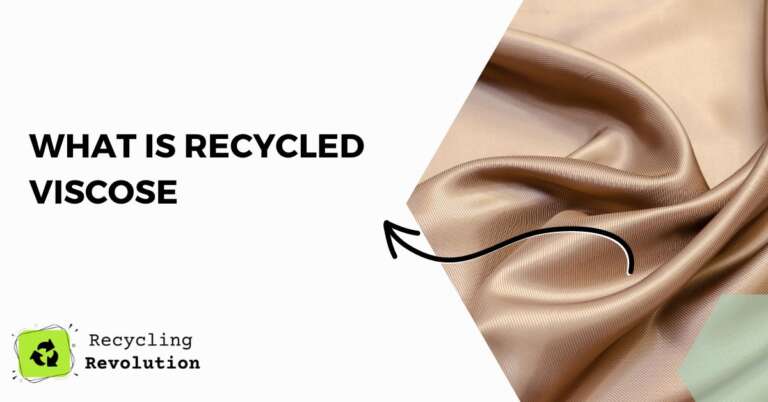Welcome to the wonderful world of eco-friendliness, where innovative, sustainable materials are playing a starring role. One material, in particular, that’s gaining considerable attention in the world of sustainable fashion and textiles is recycled viscose. But what exactly is this intriguing material?
TL;DR: Recycled viscose is a type of rayon made from regenerated, or recycled, cellulose-based materials such as wood pulp. It’s gaining popularity as a sustainable alternative to traditional viscose, offering a lower environmental impact.
Unraveling the Threads: What is Viscose?
To understand recycled viscose, first, we need to get acquainted with its traditional counterpart, viscose. Viscose, also known as rayon, is a semi-synthetic fiber made from regenerated cellulose. The cellulose often comes from wood pulp, making the end product feel silky, breathable, and drapable.
Though viscose can mimic the feel of fabrics like cotton, silk, and wool, its production process can have considerable environmental impacts.
The process often involves the use of harsh chemicals and large amounts of water. Additionally, the sourcing of the wood pulp can contribute to deforestation if not managed sustainably.
Enter Recycled Viscose: The Eco-Friendly Alternative
In response to these environmental challenges, recycled viscose has emerged. This material uses pre-consumer and post-consumer waste in its production, reusing cellulose-based materials that would otherwise go to waste. Here are some key features that set recycled viscose apart:
- Sustainable sourcing: Unlike traditional viscose, recycled viscose makes use of existing cellulose-based waste, reducing the need for new raw materials and decreasing the risk of deforestation.
- Water and chemical reduction: Recycled viscose production often incorporates closed-loop systems, significantly reducing the amount of water and harmful chemicals used.
- Waste reduction: By reusing materials that would otherwise be discarded, recycled viscose helps to minimize waste in the textile industry.
The Production Process: From Waste to Wearable
The production process for recycled viscose involves several key steps:
- Collection: The process starts with the collection of cellulose-based waste. This can include pre-consumer waste like scraps and offcuts from textile manufacturing, or post-consumer waste such as discarded clothes.
- Pulping: The collected waste is then broken down into pulp using a combination of mechanical and chemical processes.
- Dissolving: The pulp is dissolved to form a thick, honey-like liquid known as viscose.
- Spinning: The viscose liquid is then extruded through a spinneret, producing fine threads of viscose.
- Regeneration: These threads are then submerged in a chemical bath that solidifies them into the recycled viscose fibers ready for spinning into yarn and weaving into fabric.
Making the Switch: Why Choose Recycled Viscose?
I recommend opting for recycled viscose due to its multitude of benefits. Not only does it retain the desirable qualities of traditional viscose – such as softness, breathability, and drapability – it also carries significant environmental advantages.
These include a reduced carbon footprint, lower water usage, decreased chemical waste, and minimized raw material extraction.
However, as with any sustainable material, it’s important to ensure that it’s certified by a reputable body, such as the Global Recycle Standard (GRS), to guarantee its authenticity and eco-friendliness.
The Environmental Impact of Recycled Viscose
Given the widespread concern over the ecological footprint of fashion and textiles, it’s essential to consider the environmental impact of recycled viscose.
Recycled viscose can significantly reduce water consumption in the production phase, a significant boon considering the water-intensive nature of conventional viscose production. The use of recycled materials also helps to reduce pressure on forests, as the need for fresh wood pulp is minimized.
However, it’s crucial to note that not all recycled viscose is created equal. The sustainability credentials of recycled viscose can depend significantly on the source and the specifics of the production process.
Quality and Performance of Recycled Viscose
Recycled viscose retains many of the desirable characteristics of traditional viscose, making it a sought-after material in fashion and textiles. The fabric is soft, breathable, and drapes well, making it ideal for a variety of garments, from casual wear to luxurious evening gowns.
However, it’s important to remember that, like regular viscose, recycled viscose can be prone to shrinkage and wrinkling if not cared for properly. That said, with the right care and maintenance, recycled viscose garments can remain in excellent condition for a long time.
How to Identify Authentic Recycled Viscose
With the growing demand for sustainable fashion, there has been a rise in products claiming to be “green” or “eco-friendly.” Sadly, not all these claims are genuine, leading to the phenomenon known as “greenwashing.”
To ensure you’re buying authentic recycled viscose, look for third-party certifications, like the Global Recycle Standard (GRS), which validates a product’s recycled content, chain of custody, social and environmental practices, and chemical restrictions.
Advancements in Recycled Viscose Production
The production process of recycled viscose is continuously evolving, with new technologies emerging that aim to make the process even more sustainable.
These advancements include innovative methods for waste collection and separation, more efficient methods of breaking down and regenerating the cellulose, and improved systems for waste and chemical management.
In addition, there are also exciting developments in the realm of chemical recycling, which could further enhance the sustainability of recycled viscose by enabling viscose fibers to be recycled multiple times without a loss in quality.
The Role of Recycled Viscose in a Circular Economy
Recycled viscose plays a key role in the concept of a circular economy, which seeks to eliminate waste and continually use resources. By using waste as a resource, the production of recycled viscose helps to close the loop, contributing to a more sustainable and circular textile industry.
However, the move towards a circular economy is a collective effort, and requires cooperation and commitment from manufacturers, retailers, consumers, and policymakers alike.
Making an Informed Choice
Understanding the nuances of materials like recycled viscose is an important part of being an informed consumer. While recycled viscose has significant potential as a sustainable material, it’s essential to consider the bigger picture and look at aspects such as the sourcing of the waste material, the specifics of the production process, the garment’s lifecycle, and the end of life options.
Helpful Tips for Care and Maintenance
Recycled viscose, like its traditional counterpart, requires proper care to maintain its quality. Here are a few tips:
- Gentle washing: I recommend washing recycled viscose items on a gentle cycle or hand washing to prevent damage to the fibers.
- Avoiding high heat: High temperatures can cause shrinkage, so it’s best to air dry items made from recycled viscose and avoid using a hot iron.
- Professional cleaning: For certain items, professional cleaning might be the best option. Always check the care label to make sure you’re treating your garment right.
Alternatives to Recycled Viscose
If for any reason recycled viscose is not the material for you, there are other sustainable options to consider. These include organic cotton, hemp, linen, and Tencel, among others. Each has its own unique set of benefits and characteristics, so it’s about finding the right fit for your needs.
Conclusion
Recycled viscose is a powerful player in the sustainability game, offering a viable alternative to traditional viscose. By choosing this eco-friendly material, you’re not only enjoying a soft, breathable fabric but also contributing to a greener, healthier planet.
With the rise of sustainable fashion, materials like recycled viscose are set to become more common. As consumers, we can make a significant impact by supporting these innovative, eco-friendly alternatives.
Note: While recycled viscose offers considerable benefits, it’s essential to consider the full lifecycle of any product, from sourcing to disposal, to truly understand its environmental impact.
FAQs
Is recycled viscose biodegradable?
Yes, like traditional viscose, recycled viscose is biodegradable. However, the rate of decomposition can vary depending on factors such as the specific production process and any chemical treatments applied to the fabric.
How can I tell if a garment is made from recycled viscose?
The composition of a garment is typically listed on its care label. Look for terms such as ‘recycled viscose’, ‘regenerated cellulose’, or certification logos like the Global Recycle Standard (GRS).
Can recycled viscose be recycled again?
While technically possible, the recycling of viscose (including recycled viscose) is not currently widespread due to technical and economic challenges. It’s more common for viscose to be reused or downcycled. However, research and development in this area are ongoing.

